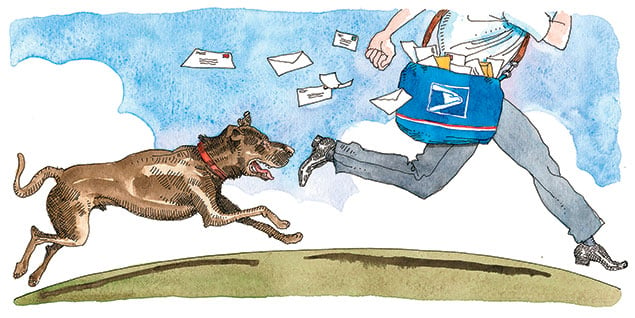If it has teeth—no matter what it is—it can what?”
“Bite,” a group of students responds halfheartedly.
Slumped into old-fashioned desks in a dingy back room of Alexandria’s Kingstowne Post Office, the six adults are training to be mail carriers. Their instructor, Marty Seegers, a veteran letter carrier, directs them to section 11-3 of their training manual: “Attacks by Dogs and Other Animals.”
Out of the blue, Seegers barks, loudly. The trainees jerk and sit up. Being alert is key, she says—you never know when a dog could jump out at you.
It’s not that Seegers dislikes dogs; her boxer, Diamond, would never hurt her. But dogs are territorial by nature and often perceive mail carriers as intruders. “Every time a dog sees a mail carrier, they start barking and going off,” Seegers says. “It’s the code of the dogs.”
The Postal Service recorded nearly 6,000 dog attacks in 2012; 169 have occurred in the Washington area so far this year. As a result, animal-safety workshops are a part of every new carrier’s curriculum.
William Hairston has delivered mail for 19 years; his current route is in Alexandria’s Virginia Hills neighborhood. “I’m a dog lover,” he says with a wide smile. “I grew up with dogs—German shepherds, pit bulls, standard poodles.” You can tell that if Hairston came across a dog on his day off, he’d crouch down and give it a good scratch behind the ear.
But he’s wary of unfamiliar dogs on his route—he still has a scar from a Chihuahua bite 15 years ago—and always has his dog spray close at hand. Made of cayenne pepper and mineral oil, Back Off Dog Repellent irritates a dog’s eyes and nose, giving a threatened mail carrier time to get away. The Postal Service requires that every carrier keep a bottle on hand.
“The dog is in a protective mode for the family,” says Pat Gold, the Postal Service’s safety specialist for Northern Virginia. Kids especially draw out this defensive state. Taking mail straight from your carrier is a bad idea, as a dog could interpret the act of handing something to you as aggressive. Hairston says you should wait until your carrier leaves the property before letting your dog out or retrieving your latest coupon from Bed Bath & Beyond. Make sure to lock your door, too: Dogs have been known to jump up and hit the latch, swinging a door open.
Back in class, Seegers shows her students how to use a mail bag as a shield to fend off a dog. Another trick: whistling. It announces a mail carrier’s presence in a dog’s domain without alarming the protective animal.
Seegers teaches trainees to look for certain behaviors once a dog is in sight. If the animal approaches with fur raised and a dead stare, carriers should stop and firmly command, “No” or “Go home.” Dogs can sense fear, so carriers are trained not to turn and run away. A dog with a rigid, straight body is another sign of aggression, whereas a bounding stride, with a curved back and wagging tail, usually signals harmless curiosity.
Though mail carriers aren’t allowed to pet or play with dogs on the job, animal lovers still get to know some of the ones on their rounds. A chubby chocolate Lab on Hairston’s route has become a favorite.
“She’s always lying down because she’s overweight,” he says. “Then she’ll see me, struggle to get up, come over wagging her tail, and usually hit me on the leg and fall down because she wants me to rub her. I’m like, ‘Come on, I don’t have time for this.’ ”
You can tell he wishes he did.
This article appears in the December 2013 issue of Washingtonian.


















